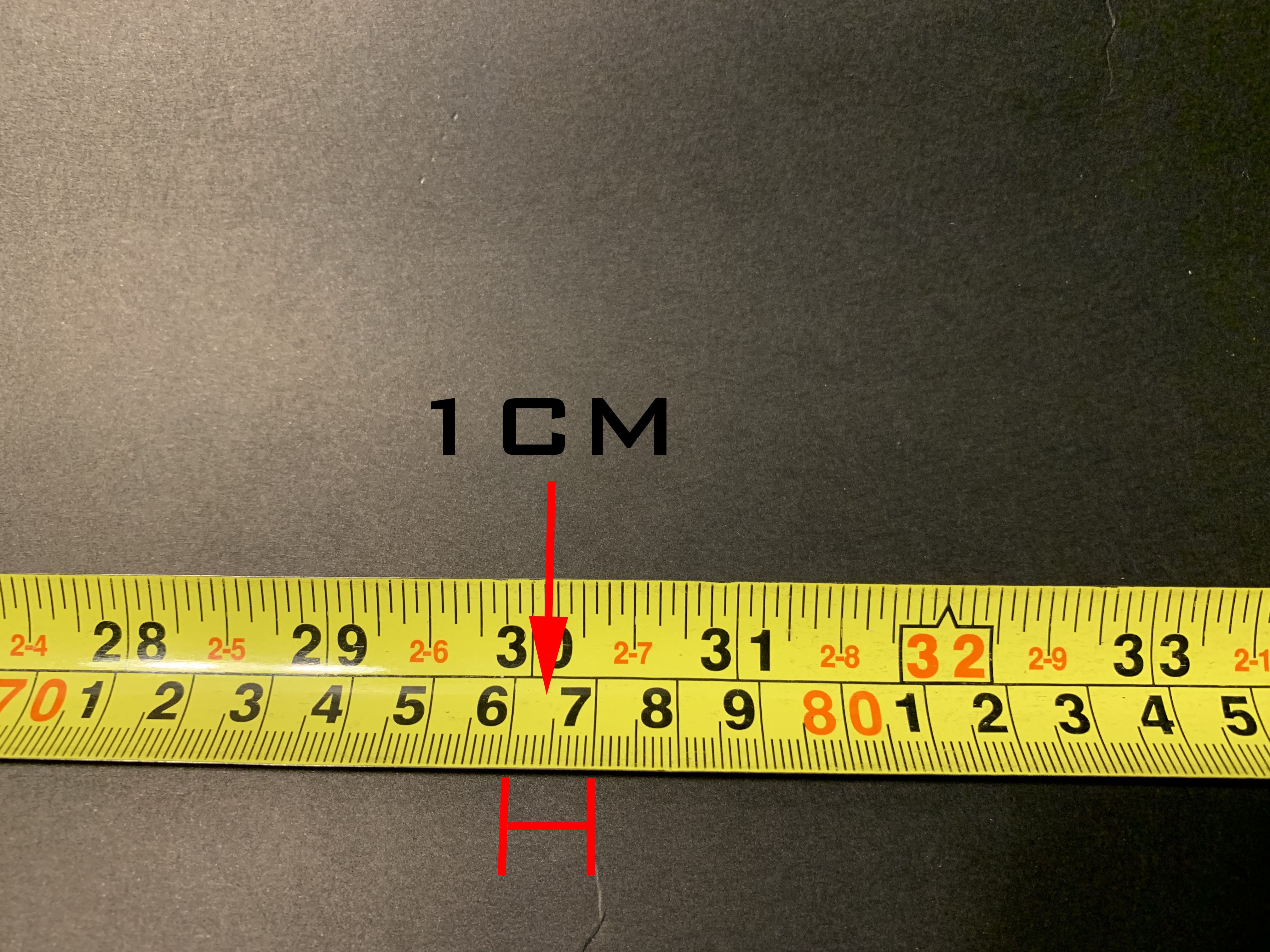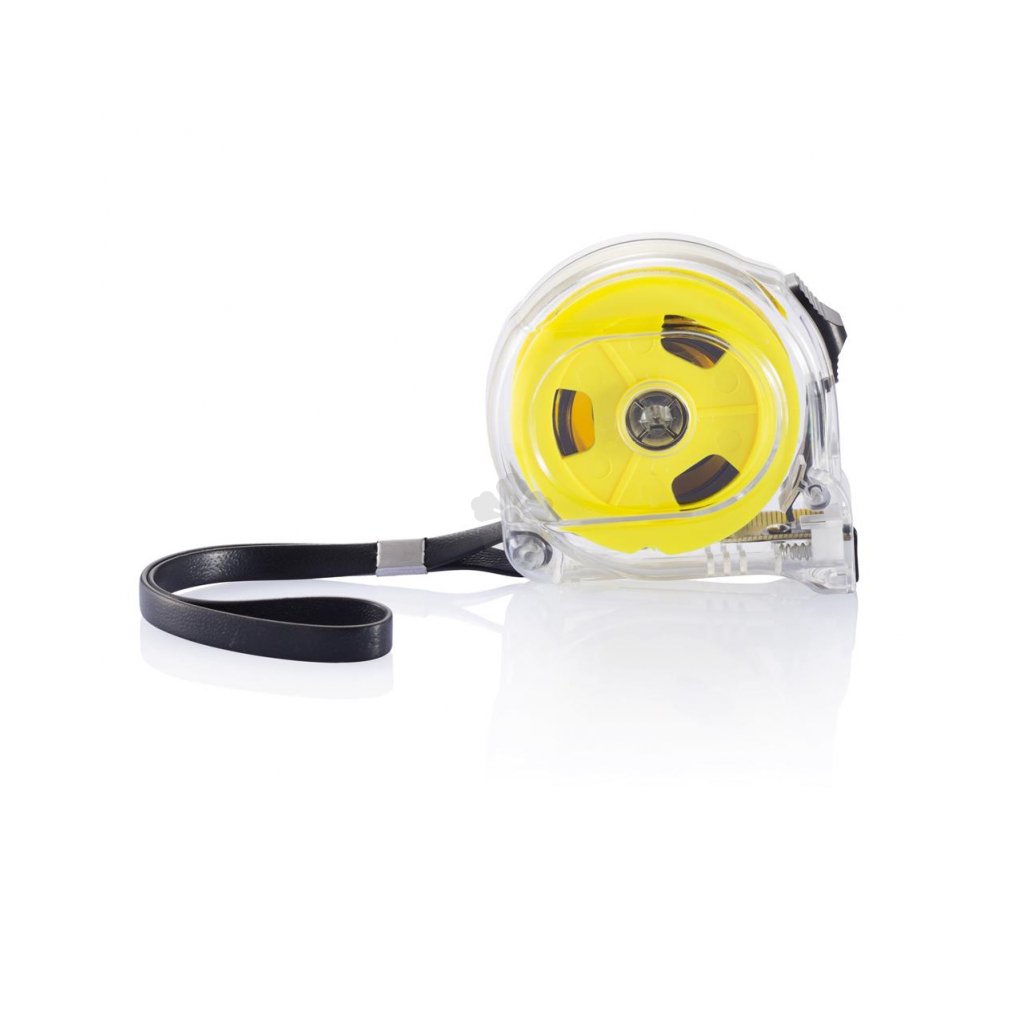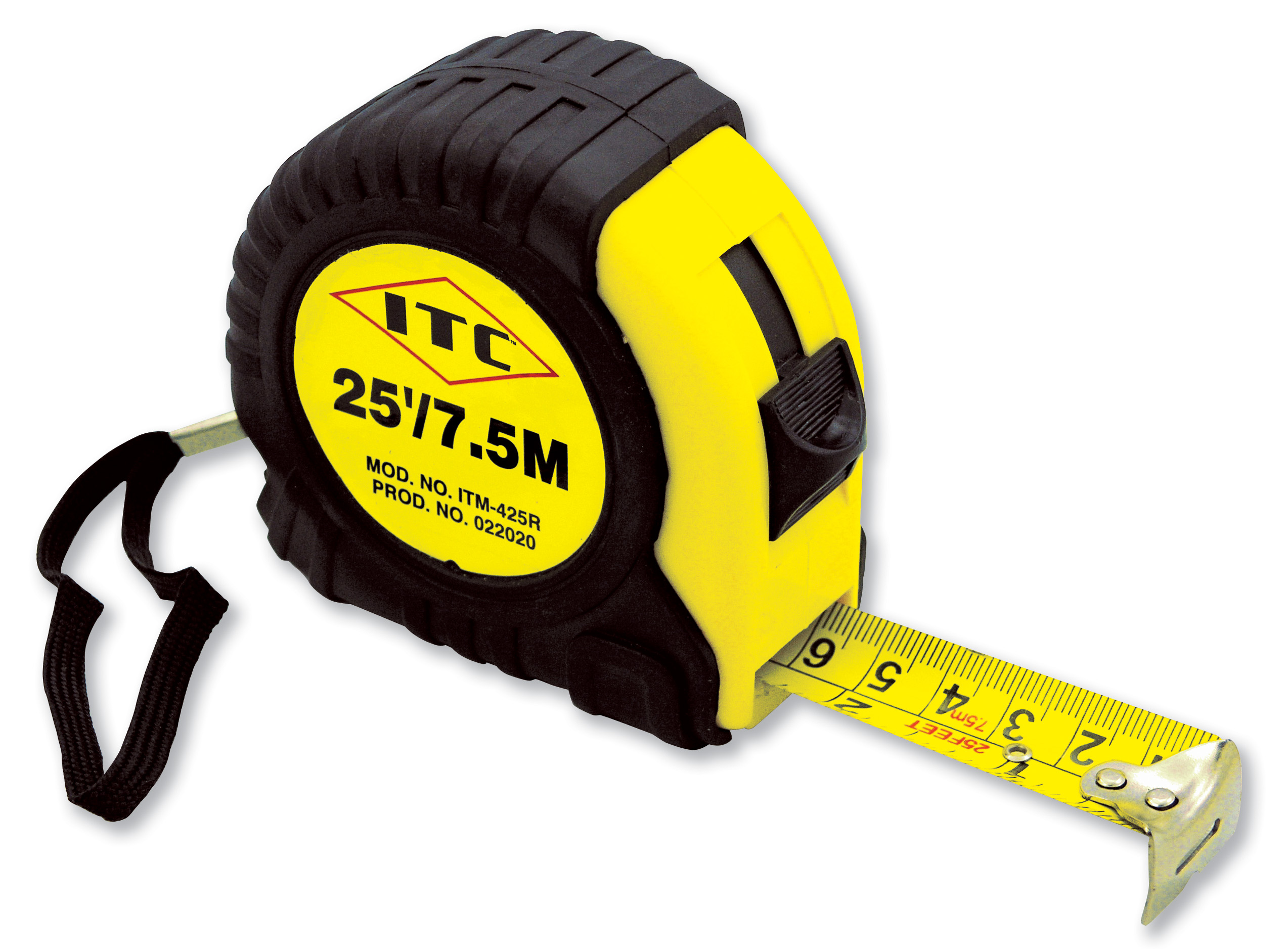Tape measures are often designed for specific uses or trades. Tapes may have different scales, be made of different materials, and be of different lengths depending on the intended use. Tape measures that were intended for use in tailoring or dressmaking were made from flexible cloth or plastic. These types of tape measures were mainly used for the measuring of the subject's waist line. Today, measuring tapes made for sewing are made of fiberglass, which does not tear or stretch as easily. This type of tape measure will have a floating tang or hook on the end to aid measuring.
The tang is connected to the tape with loose rivets through oval holes, and can move a distance equal to its thickness, to provide both inside and outside measurements that are accurate. A tape measure of 25 or even 100 feet can wind into a relatively small container. The self-marking tape measure allows the user an accurate one hand measure.
A tape measure is effectively a flexible ruler that is usually sprung on a retractable mechanism for easy storage, helping to measure the distance or size of any space or object. With linear-measured markings usually covering a number of different scales, a measuring tape can be many different materials. Flexible fabric options are great for accurate measurements across circular or jagged surfaces. Measure tapes often have a floating tang or hook at the end, sometimes magnetic, to secure them in place when in use which is ideal if working alone or in awkward spaces. In the US, the standard tape measure will measure in Imperial units—that's feet and inches—while the rest of the world uses metric tape measures to measure in meters and centimeters. No matter which measurement system your measuring tape follows, the basic anatomy of the tool and how to read it remain the same.
In the US, the standard tape measure will measure in Imperial units—that's feet and inches—while the rest of the world uses metric tape measures to measure in meters and centimeters. This measuring tape features metric on the white side of the tape and imperial measurements on the black side. The stark contrast between the coloured sides makes it quick and easy to flip to the measurement style of your choice.
The text and lines are clear and supremely easy to read. Sourced from Germany by Merchant & Mills, this tape measure features metal tips for accurate measuring and is not prone to stretching out over time. Most standard tape measures in the U.S. have markings that measure down to 1/16 of an inch. These are smaller, sometimes thinner markings, evenly spaced between the half-inch and inch marks on a tape measure. On some tapes, quarter inch marks are the same size as eighth-inch marks.
Remember that two sixteenths of an inch equals one eighth, two eighths of an inch equals one quarter, and 2 quarters equals one half. For example, the second eighth-inch marking after the inch marking is a quarter inch. Imperial measurement can be a bit tricky, especially or those who have been brought up using Metric measurement. The Imperial measure used extensively in the US, is split to feet, inches and fractions of an inch. The next is the 1/8th of an inch with a slightly longer hash mark. These are longer again, and 2/8ths, 4/8ths, and 6/8ths are marked as quarter inches.
The ½ inch is marked with a yet longer hash, and then each inch is marked with a hash that runs across the width of the measure, and a number. As we know, 12 inches make up a foot, and these are marked with 1F, 2F, 3F, and so on. Sometimes you will find that on one edge that after the foot marker, the inches will increase again by single digits to reach 12 for a the next foot. On the other edge the inches will keep numbering incrementally, so 1ft 2 inches will register as 14 inches, and so on.
At three feet, for example, it would measure 36 inches. Reading a tape measure correctly is a necessary skill when taking on DIY projects. Tape measures are available in both standard or imperial units and in metric units. Plus, you'll learn some tips and tricks for using this tool to get precise measurements. In some countries such as the UK, tape measures have both Imperial and Metric measurement markings.
Until recently in the US, for example, all tape measures were in Imperial units, however the dual standard option is becoming more widely available. Just as you would with a retractable tape measure, look for the spot where the end of the object or distance you're measuring lines up with the tape measure. If the tape measure stretches exactly halfway between the 27 and 28 inch markings, this means that your arm is 27.5 inches long. On a tape measure labeled with imperial units, the most prominent marks are usually the one-inch marks. These are typically marked by long, thin lines and fairly large numbers.
The sale of dual Metric/US Customary scale measuring tapes is slowly becoming common in the United States. For example, in some Walmarts there are Hyper Tough brand tapes available in both US customary units and Metric units. So, the inclusion of a metric scale requires the measuring device either to contain 3 scales of measurement or the elimination of one of the US Customary scales. On a tape measure that uses imperial units – as opposed to the metric system – the most prominent markings are typically the inch marks, designated by long, thin lines and larger numbers.
You will see a foot designation marked every 12 inches . Reading a tape measure is a skill you can easily master. Using this small, sturdy hand tool can improve the accuracy of your project measurements. Learning how to use a tape measure properly means to always "measure twice, cut once." You can use a standard tape measure or opt for a metric one. The Home Depot delivers online orders when and where you need them. To read a measuring tape, line the zero mark up at the edge of the item you're measuring, then stretch the tape all the way across the item.
Try to keep the tape straight to ensure an accurate measurement! Then, look at the point where the tape meets the end of the item you're measuring and read the nearest large number. The large numbers are the units you're measuring, like inches or centimeters, and the markings between the large numbers correspond to fractions of that unit. On most metric measuring tapes, centimetres are the most prominent markings.
Centimetres are usually labeled with large lines and, next to each line, a number. As with inches, the line marks each centimetre, not the number itself. Sixteenth-inch marks are considered as the shortest lines of all measuring tapes. You will find 16 tiny marks per inches and 4 in each quarter inch. But if you DO end up needing or using a metric tape measure, know that for every meter, there are 100 cm and for every cm, there are 10 mm. Most metric measuring tapes only mark the cm for readability, so you'll need to count the number of ticks in between to get your exact measurement.
Sometimes, there are larger ticks in between each cm to denote 1/2 cm. Building and construction practice calls for all measurements to be made in millimeters . These are the smallest unit on the tape measure scale, and are also marked with the smalles hash mark along the edge. As they are so small, they are generally not individually numbered on tape measures.
Ten millimeters make up a centimeter and these are marked with a number, and a bigger hash mark. Every tenth centimeter is highlighted, so they can be easily picked out. A hundred centimeters make up a meter , which is again clearly marked on a tape measure with a hash mark that will extend across the width. In the United States, the imperial measurement system is normally used on a tape measure, though some models may have both the imperial and the metric system.
Whilst Britain now officially operates a metric system of measurement, our nation still sees a curious mix of both metric and imperial measurements being used on a day to day basis. We measure our height in feet and inches, our weight in stones and pounds and our speed in miles per hour. Despite this almost all 21st Century technical, engineering or construction measurements are quoted in millimetres. Most manufacturers have, therefore, opted to produce UK-spec tape measures with both metric and imperial graduations. In metric measuring tapes, centimeters are the most significant markings.
Centimeters are generally represented by the large lines , and you will see a number next to each line. Use the tiny, densely-packed marks for sixteenths of an inch. The shortest lines of all on most measuring tapes are the sixteenth-inch marks.
Use the same pattern for recognizing these minuscule measurements. The use of millimeter only tape measures for housing construction is a part of the US metric building code. Millimeters produce whole numbers, reduce arithmetic errors, thus decreasing wastage due to such errors. Normally, marks are black and red on a yellow background, as this is the best colour combination to make it easy to read. Standard or SAE tape measures clearly show feet, inches and fractions of inches. The measurements on a tape measure are generally 16 marks to the inch.
Laser distance measurers can often measure accurately within 1/16 inch. You might be one of those people who just think the hook at the end of the tape measure is so you can easily roll the end of the reel. Well, it's a much more sophisticated than meets the eye.
The hook is called the 'tang', and is attached to the blade of the tape measure using a couple of rivets. However, if you have noticed the tang is not held in a permanent position, and floats at the end with a little give. This little piece of shaped metal, makes measuring an internal measurement just as easy as taking an external. By pushing the tang up to an internal edge it butts up tight to the end of the tape measure blade to give an accurate reading.
This 300' double-sided measuring tape from Lufkin features imperial and metric measurements to suit any situation requiring precise lengths. Its 40+ strand fibreglass design greatly reduces blade stretching and provides superior resistance to kinks. It includes a comfortable over-mould rubber handle and a tubular protective ring to prevent damage to the blade.
When your measurements are taken, the tape can quickly be rewound for easy storage. Above you'll see a picture of a metric/imperial pocket tape measure. The measurements towards the bottom of the image are metric.
In other words they're in centimetres and milimetres. There are 10mm in each centimetre and 100cm in each metre. Whilst the centimetres are clearly numbered, to make the blade easier to read the millimetres arenotnumbered. Also, whilst a few tapes show '1m' to display the 1 metre mark, the majority will show '100cm'.
On the tape measure marked with imperial units, you will find the most significant marks are commonly the 1-inch marks. These are usually marked by long thin lines and represented by the large numeric value. These removable, adhesive backed measuring tapes are used for marking fabric or sewing tables for quick measurements while cutting or trimming.
The tape does not adhere well to damp or wet surfaces, so make sure the surface is relatively clean and dry. I use this along the edge of my sewing table for quick measurements. Personally I much prefer this type of measuring tapes for sewing. Converting lengths for sewing is simple using a tailor's tape marked in both cm and inch.
All you need to do is read the inch side corresponding to the number in centimeters. If we have to convert for example 66 cm into inches, looking at the image below we can see the result is 26 inches. Metric tape measures have similar markings to imperial models, but the markings represent centimeters and millimeters. The larger markings on a metric tape with numbers are the centimeters and the smaller marks are millimeters. Use the smaller markings between centimetres for 0.5 centimetres.
Some metric measuring tapes will have medium-sized marks evenly spaced between each centimetre mark. It consists of a ribbon of cloth, plastic, fibre glass, or metal strip with linear measurement markings. Its design allows for a measure of great length to be easily carried in pocket or toolkit and permits one to measure around curves or corners. Today it is ubiquitous, even appearing in miniature form as a keychain fob, or novelty item.
Surveyors use tape measures in lengths of over 100 m. A tape measure, also known as measuring tape, is usually a flexible tape used to measure length. Generally, tape measures are built from different materials, like plastic, fiberglass, and cloth.
When we talk about the constructional work and craftsmanship, it is among the most effective measuring tools used nowadays. The tape measure for sewing is usually soft and flexible strip/ribbon with linear-measurement markings made mostly from reinforced polyester or fiberglass. The most common length of a measuring tape is 60 inches , but there are tapes for sale, for example, 100 inches long or even longer 120" which can be useful for measuring longer lengths . I lost the tape measure I keep in my handbag so looked online for a replacement.
Concerned about getting an inferior product which might stretch I visited a REAL shop and had a good look at what I was buying. This appeared to be a good strong item and still seems so in use. It's narrower than my previous one but I can live with that. The reason for 4 stars not 5 is that the numbers on the metric side are equally distant from the centimetre markings either side of them. We will start with the metric system since that is slightly easier. Only they are not written as 1, 2, 3, 4, decimeters on the tape measures.

























